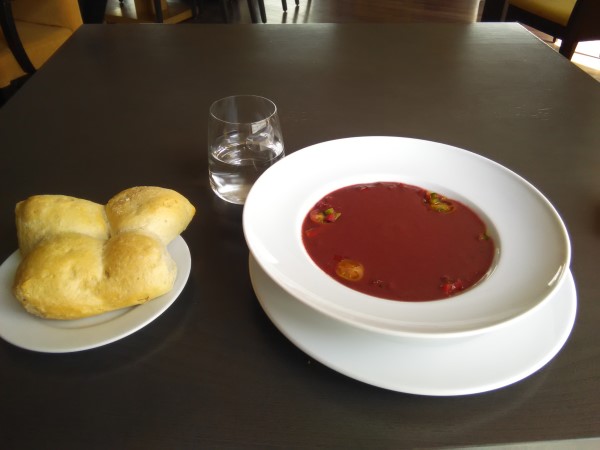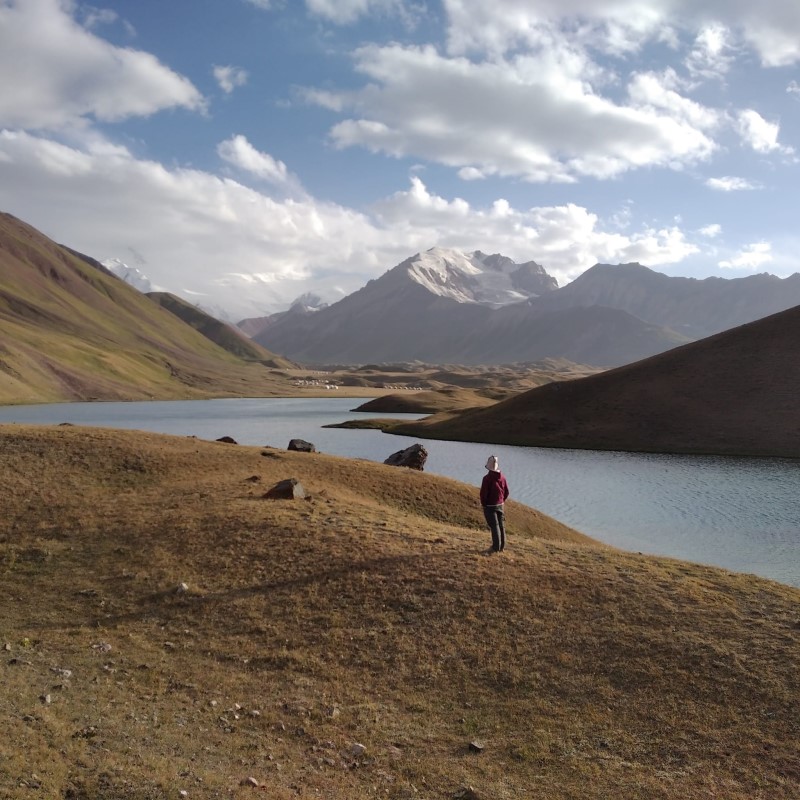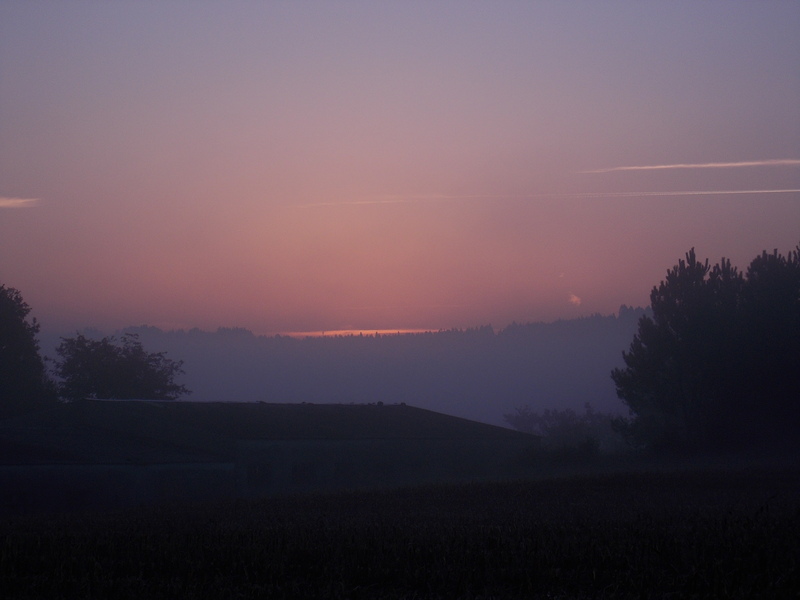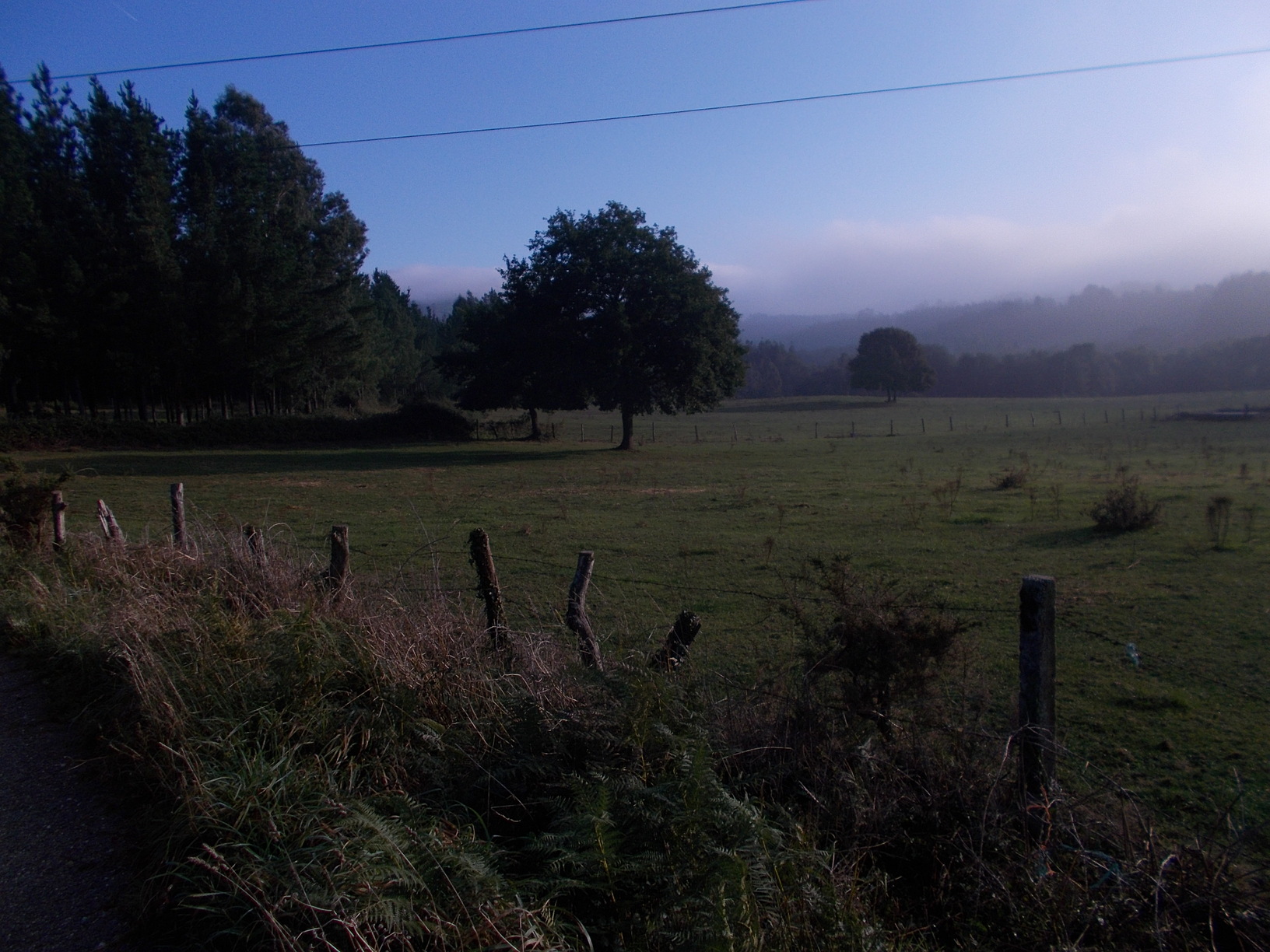
Basic Details
- Starting point: Pilgrim albergue in a small village of Priesca.
- Ending point: The old center of Gijon (with a couple of good hostels).
- Availability of alternative routes: Not really. As every other big city on the beautiful northern coast of Spain, Gijon has a path on the coast, on both West and East side of the town. However, since you walk to Gijon from the interior of Asturias, trying to get to the coast would be a huge detour (at least 10 extra kilometers with a lot of extra elevation). I walked this coastal route just from interest once I was staying for a few days in Gijon, and it is nice, with a few spots worth mentioning, such as the Viewpoint of the Providence, or a wonderful beach of La Nora, known especially among surfers for strong waves. You can visit these locations if you decide to make a day off in Gijon and feel like walking a bit (10-12km) without a backpack. But as an alternative route for pilgrims I cannot really recommend it.
- Distance: 37 km (download GPS here).
- Elevation difference: +863m, – 969m
- Link to online map: here.
- Difficulty score: 5/5.
- Beauty score: 3/5.
- Terrain/asphalt: 20%/80% (considering how close we actually are to the big city, 80% asphalt isn’t too bad).
- Next stage: Camino del Norte, stage no. 18, Gijon – Aviles.
- Previous stage: Camino del Norte, stage no. 16, Ribadesella – Priesca.
- Connection to Camino Primitivo: Villaviciosa – Oviedo, Camino del Norte to Camino Primitivo.
Elevation profile for the route

– This is no doubt one of the hardest stages on the entire Camino del Norte, at least if you follow our guide. Especially the hill between Viallaviciosa and Deva, with 400 meters positive elevation on less than 4 kilometers, will test the legs of every pilgrim. And once you think you’re over it, there’s another climb of 200 meters on 2 kilometers. The last 12 kilometers are all downhill or flat, however, with plenty of bars and refreshment points on the outskirts of Gijon, so once you’re over the two hills in the middle of this stage you will be fine.
Advanced info about the stage
- Trail marking: First of all, there is an important split, right after Villaviciosa, right in front of a small chapel called Ermita de Casquita. Here you can either continue straight to Gijon, or turn left and go to Oviedo instead, from where you can either follow the Camino Primitivo (* we do not have a guide for this Camino yet, but it is a work in progress), or simply visit the city and return back to the coast, some 25 kilometers onward, in the city of Aviles. Many pilgrims do this, for one of the two reasons: 1. To avoid the most ugly stage of Camino del Norte, from Gijon to Aviles; 2. To get to know the city of Oviedo. In my opinion, Oviedo isn’t really nicer than Gijon, but of course it is up to you to consider this variant. Roughly 25% of pilgrims opt for it. In terms of train marking on the way to Gijon it is relatively good, but it gets worse in Deva, once you are already in the outskirts of Gijon. There is a yellow arrow on each crossroad, but sometimes it is small or placed on a peculiar spot (often hidden by parked cars or construction work). On this section of the walk, it is definitely better checking once in a while with your phone, whether you are still on the Camino.
- Natural places worth seeing: The first few kilometers from Priesca pass through some nice and relatively rural countryside of Asturias. You can see cow and sheep herds, and you will pass by a nice small waterfall (check the gallery below). Overall the first few kilometers are really nice, with lot of green and a river always flowing nearby. Then after Villaviciosa the first 3-4 kilometers are also nice, though many pilgrims do not enjoy them because of the steep gradient of the climb :). One you are in Gijon already, I really like the city beach of San Lorenzo, which has a great vibe year-round, and the promenade is ideal for a romantic late evening walk with a fellow pilgrim… And one insider tip: The is a beautiful botanical garden on the outskirts of Gijon (about 1 km detour from the Camino), where you can marvel on hundreds of various plants and flowers (and also some animals) typical for a Asturias and for the Cantabric sea area. Due to lot of trees and water flowing all around, this botanical garden is a pleasant place to visit even in the heat of summer, because it is always a few degrees colder there ;).
- Historical, architectural, and culinary places worth seeing:
- The old center of Gijon is definitely worth a visit. It isn’t big, just at the edge of the beach of San Lorenzo, so if you stay in one of the hostels/pensions in the center of the town, you can always reach it within 15 minutes (or less) of walking.
- Palacio de la Torre de Nievares – A very specific ruin of a former palace, with interesting architecture and beautiful views. Just 250 meters detour from the Camino, and definitely one worth making.
- Villavisiosa offers a few historical buildings to visit. Probably the most interesting one is the church of San Salvador de Vadedios, dating back to 9th century, and very well preserved, in a wonderful location. It is a two km detour (2 km there and 2 km back), hence I recommend it mostly to people who decide to stay for the night in Villaviciosa.
- In terms of culinary experiences, Gijon is a wonderful city for people with all sorts of tastes. I especially recommend the vegetarian and vegan restaurants in the city–Gijon is definitely one of the most progressive cities in Spain when it comes to plant-based diet, and you will find at least five great restaurants of this type in the city. But it has places for any other dietary preferences as well :).
- Camping/bivouac options on this stage: Really rough, especially once you are close to Gijon. The zone is full of buildings, small industry, private properties, and not really any good place to pitch a tent or to bivouac. There are some good spots on the coast between Villaviciosa nad Gijon. However, since you are walking in the interior, it is quite far away to actually get to the coast… Also once you are within a moderate run (10 km) distance from Gijon, you’ll always have city people running or walking with their dogs in the zone, trying to escape the buzz of the big city at least for a while. Hence it is hard to find a spot where you’ll be at least a bit protected with your tent or sleeping bag… In terms of organized camping places, however, you have one option in Deva:
- Camping Deva: The camping actually runs a pilgrim albergue as well, so you can stay there even if you do not have a tent. Beware though that the place has a bad reputation, and I recommend it only as an emergency option. The dogs are allowed only in the camping area, so if you stay in an albergue or in the bungalow, your dog isn’t allowed to stay with you. Keep this on your mind if you consider this camping because you are doing the Camino with your beloved companion.
- Dog friendly score: 2/5. While this stage is relatively green and there are enough spots with shade, and you are always close to river the first 10 kilometers of the walk, I still cannot give it more than 2/5. Because there’s just too much asphalt walk for the god, there aren’t any pilgrim-friendly accommodation options that accept dogs in Gijon (there are some rural hotels and private apartments that accept dogs, but the price is from 80 euro up per night), and some roads close to the center of Gijon are also pretty busy with cars. If you walk with the dog, it is better to either turn to the Camino Primitivo after Villaviciosa, or to skip the zone of Gijon and Avilles, taking a train ride for this part, and continue from Aviles onward, from where it is much more dog-friendly again.
- Special remarks: Today you will reach a point where you can leave Camino del Norte, and head to Camino Primitivo, in the direction of Oviedo. The point is very well marked, 2 kilometers after Villaviciosa, and we map the connecting stage between the two Caminos here: Villaviciosa – Oviedo, connection from Camino del Norte to Camino Primitivo.
Accommodation options on today’s stage
* The infographic displays the number of pilgrim hostels (only pilgrims allowed), hostels (anyone allowed, shared rooms), and other accommodation options (hotels, pensions, etc, private rooms) in each point along the route, together with price range. For exact explanation of the pictograms we use check the explanations page. Below the infographic you will see our recommended picks (up to 3 pilgrim options and 1-2 “privacy” options, maximum five) for the stage, together with important information (but not too much info, just what you need :-)).

Recommended places to sleep along this stage
Pilgrim options:
- Albergue La Oveja Negra, Barzana (km 3). Location and reviews on Google maps here. 12 beds, donation based, communal dinner, all installations are very new (the albergue opened in 2024 only). The place is run by an experienced hospitalero (who ran another donativo on Camino del Norte before), and has excellent reviews across all platforms. Definitely recommended.
- Albergue La Casa de Montse, Villaviciosa (km 9). Location and reviews on Google maps here. A super nice small pilgrim albergue with a friendly and caring host. Donation based, 5 beds. On the outskirts of Villaviciosa, in a location “La Trocha” with communal dinner and breakfast. Highly recommended. Check-in from 2pm, make a reservation by a phone call, +34 651 068 840.
- Boogalow Hostel, Gijon (km 37). Definitely the best hostel in Gijon. Great vibe, wonderful communal zone, perfect location, and well equipped kitchen. 25 beds, prices start at 25 euro/night (and can go up to 35 in summer). However, due to the elevated price for hostels it doesn’t attract the typical city drunkards, and you will have a great time here. Check-in from 2pm to 9pm. Recommended way of making a reservation: website of the hostel, or booking.com.
Privacy/luxury options:
- Residencia Universitaria Cimadevilla, Gijon (km 37). Location and reviews on Google maps here. A perfect place if you look for affordable privacy in Gijon. 20 euro/night for a private room with bathroom–cannot get much better really, and you will struggle to find a bed in a hostel in Gijon for such a price–let alone a private room. Sure, it is a university dorm during the year, so you cannot expect to encounter here a pilgrim spirit or some super new amenities, but the rooms are good enough and for the price it is an unbeatable privacy option for the city of Gijon. Recommended way of making a reservation: phone call, +34 984 198 504.
- Noma Butique Hotel, Gijon (km 37). Location and reviews on Google maps here. A beautiful 4 stars butique hotel, definitely one of the best (if not the best) in terms of price/quality ratio in Gijon. Central location (close to both beaches), yet a bit hidden on a quieter street. Prices start from 85 euro/room, check in from 4pm. It is almost a luxury hotel, but for an affordable price. Recommended way of making a reservation: booking.com.
Pictures from the stage
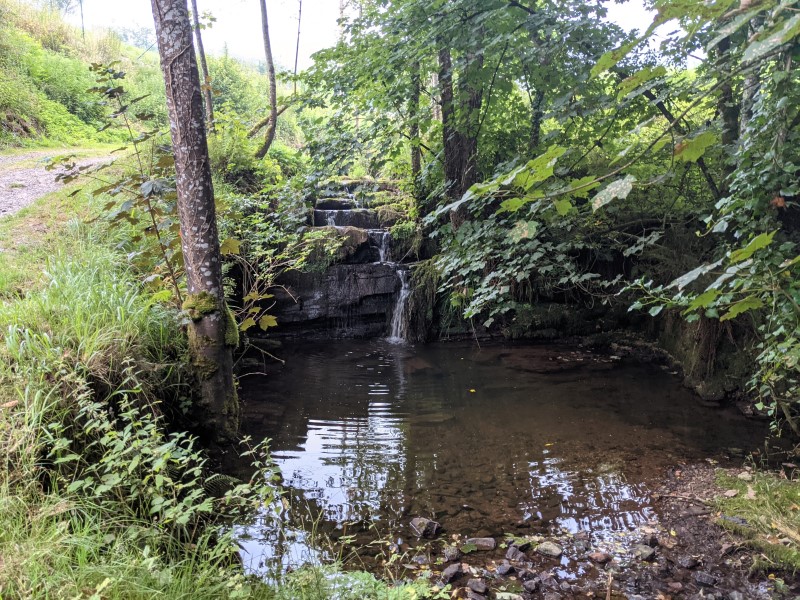 – A small waterfall on your initial descent from Priesca. Of course it doesn’t come even close to some waterfalls you will find in Spanish mountains, but it is nice to see it anyway, especially since it is right on the Camino and no detour is needed.
– A small waterfall on your initial descent from Priesca. Of course it doesn’t come even close to some waterfalls you will find in Spanish mountains, but it is nice to see it anyway, especially since it is right on the Camino and no detour is needed.
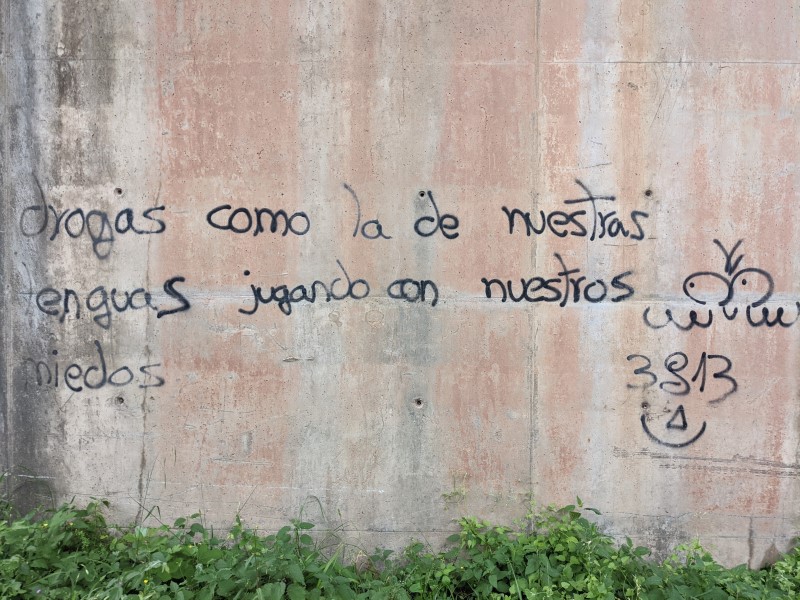 – I am not a big fan of people spraying messages on the walls. What I like about graffiti in Spain, however, is that they often have a deeper sense and make one think…
– I am not a big fan of people spraying messages on the walls. What I like about graffiti in Spain, however, is that they often have a deeper sense and make one think…
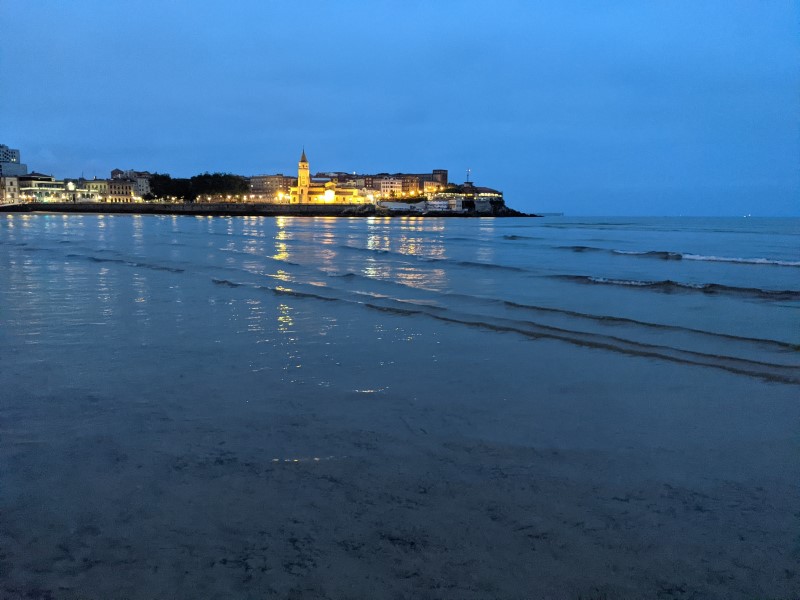 – The beautiful beach of Gijon in the evening, with the Church of San Pedro and other historical buildings illuminating the night. If you stay in the center, you will have this beach always within a few minutes of walking.
– The beautiful beach of Gijon in the evening, with the Church of San Pedro and other historical buildings illuminating the night. If you stay in the center, you will have this beach always within a few minutes of walking.
 – Walking in the interior of Asturias (instead of a coast) for a change has some advantages. For example you can meet many nice cows (and other animals) on your way.
– Walking in the interior of Asturias (instead of a coast) for a change has some advantages. For example you can meet many nice cows (and other animals) on your way.
Few tips at the end
- From the bigger coastal cities on your Camino, Gijon is definitely the nicest one. It has a nice historic center, lot of green zones, some wonderful restaurants (including vegan), and a super nice beach where dogs are allowed outside of the main summer season (and it is just wonderful watching them play around there in dozens). If you feel like making a day off, Gijon is a good place to do so. Just remember that this city is expensive, in all seasons of the year, and even a bed in a 8-bed dorm in a hostel will cost you at least 25 euros a night.
- If you find this stage too long, I highly recommend braking it in two and stay in a wonderful albergue in a small hamlet of Capion, outside of Peon. The place has an excellent reputation in the pilgrims’ circles, and is run with love. It is outside of the Camino, but they will come to pick you up by car and the next day drive you back (if you do not feel like walking the extra 3.6 km). From there you will have relatively short 15 km left to reach the old center of Gijon, hence if you do not plan an off-day in the city, you have plenty of time to explore it a bit and enjoy the facilities each big city offers.
Next/Previous Stage
- Next stage: Camino del Norte, stage no. 18, Gijon – Aviles.
- Previous stage: Camino del Norte, stage no. 16, Ribadesella – Priesca.
- Connection to Camino Primitivo: Villaviciosa – Oviedo, Camino del Norte to Camino Primitivo.



![Ultralight Packing List for Camino de Santiago [2025 Edition]](https://caminolovers.com/wp-content/uploads/2022/03/altra-shoes-640-x-480.jpg)
